North Vietnam Food – Ride To Northeastern Lands For An Amazing Discovery
While you travel to Northern Vietnam, one of the most exciting activities that you cannot turn away from is seeking to try special North Vietnam foods. If we introduced you to the distinctive features of Northwest Vietnam cuisine in the last article, this one would take you to the world of the tastiest dishes in the Northeast region.
Of course, when it comes to places with diverse terrains with highlands, rivers, and seas, all kinds of experiences can be incredible. The borderland of North Vietnam is one such special place where travelers have a chance to discover Northeast Vietnam cuisine with its rustic charm and local uniqueness.
One shall find that Northeast Vietnam food is varied in preparing methods and ingredients such as poultry, meat, sweet water, fish, and seafood. Also, the dishes of sticky rice and dumpling are amazingly numerous. Today, together with vietnammotorbiketoursclub, let’s explore the sundry cuisine of this generous land.
Northeast Vietnam food – Dishes from meat
The diversity of North Vietnam food is greatly contributed by unique dishes made from numerous types of meat, such as chicken and pig, and dug in the Northeastern land. Please scroll down; then, you will find many interesting things.
Free-range chickens
Wild chicken bred and kept on hillsides is a delicate food of the local Northeast people. Other than to serve in ancestral commemorations or to please distinguished visitors, they rarely butcher these little poultries.
There are various ways to prepare the chicken, but it is most delicious if boiled, steamed, or grilled over charcoal with herbs like leaves of clause (mac mat) or Indian pepper (mac khen). The chicken exudes a special gamy, sweet scent and shows firm grain, juicy but not soggy meat. It matches best with steamed sweet rice or bamboo stem rice. Together they make both chewing and digesting these dishes much more pleasurable.
Carried-under-arm pig – a local speciality
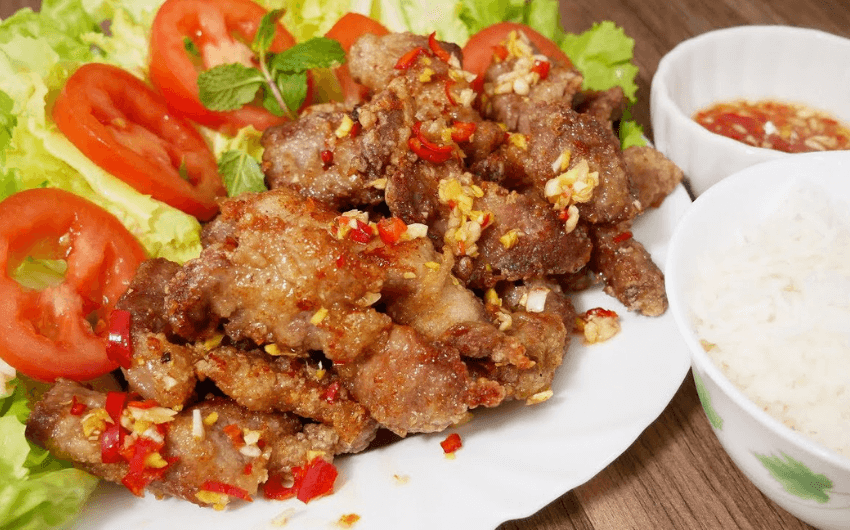
Carried-under-arm pig is a particular swine widely kept in the house of Northeast native people. They usually take down these pigs during the Tet festival or other major events. The pigs grow slowly; after a whole year, they reach 25 to 30 kg, ready to be slaughtered.
The pigs can be cooked in various styles: assorted on a wicker tray, roasted whole, or grilled with clause leaves and Indian pepper. Try one bite and be amazed by the crunchy skin and firm and succulent meat. It is much tastier and smells superior to the city swine fed with industrial rice bran in lowland areas.
The most famous seven-flavor roasted duck in Cao Bang
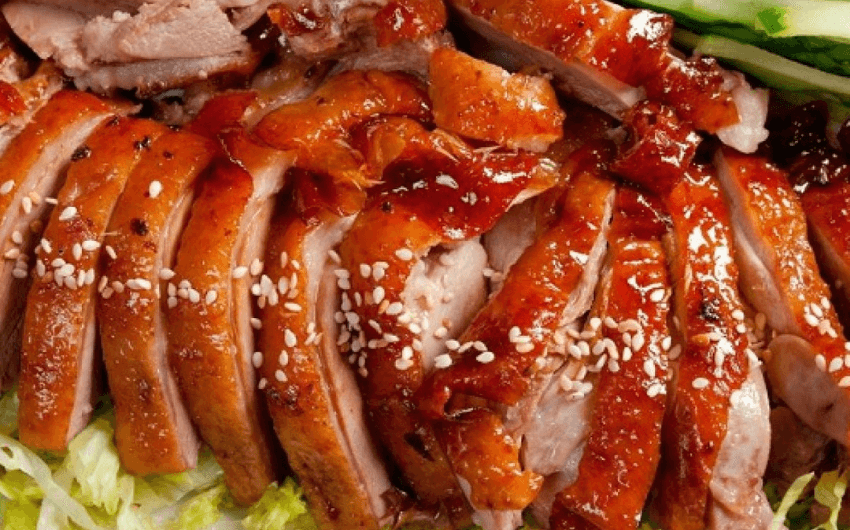
It is the proud dish of the Cao Bang people. The high-quality, fresh duck is dry marinated in seven different mixes of herbs and spices and cooked into seven distinctly different dishes to satisfy all your appetite. Bring a well-prepared empty stomach to accommodate all seven dishes and experience a new flavor explosion for every dish!
You’ll grow fond of the amber-brown skin while enjoying the crackling sound as it melts in your mouth. The lust meat is very aromatic and gives long-lasting sweetness on every chew.
Dry-aged meat – A special feature in the Northeast Vietnam food culture
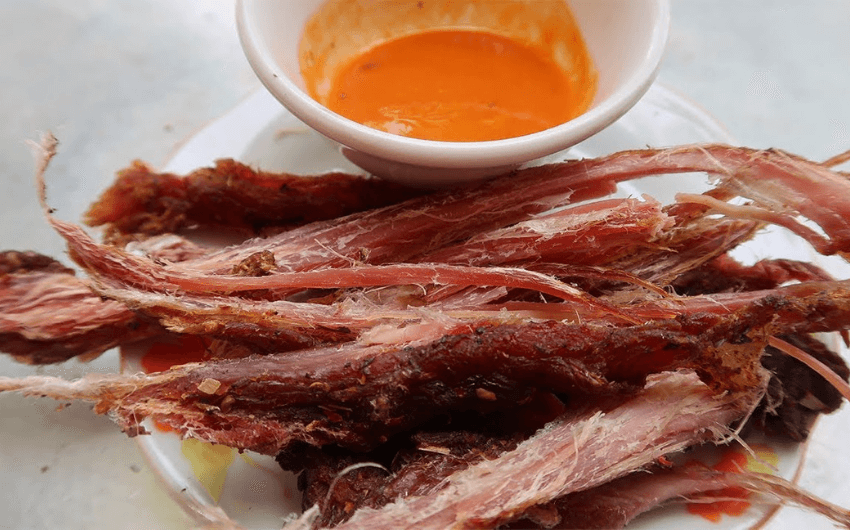
The people here hang every kind of meat over their kitchen stove for dry aging, whether beef, buffalo, pork, chicken, or sausages. The fragrant smoke from forestland firewood matures the meat and gives it a firm texture and classy flavors. In the past, indigenous people used meat hanging to stock meat for seasonal hard times, especially in Sapa. Recently, its product has caught a trend and become snacks and finger food everywhere.
Thang co – a Northeast horse meat specialty
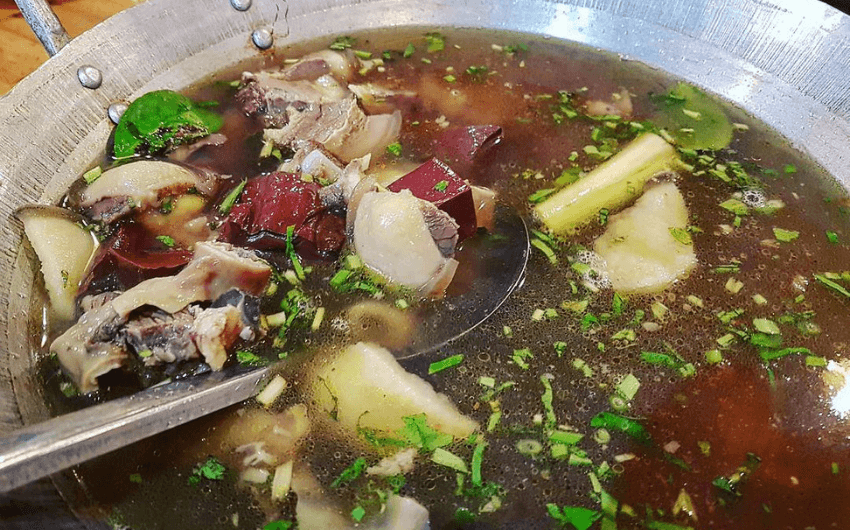
The karst plateau of Dong Van is famous for its meticulous horse meat simmering pot- thang co. Horse meat and intestines are chopped into appropriate sizes and put into a pot to simmer with herbs distinct to these mountains: Indian pepper, clausena leaves, ginger, lemongrass, etc. On the high-hanging stony highland, a fuming thang co pot can spice up the cold winter air with its exciting aroma. Sipping down some strong maize wine with a hot bowl of thang co is a way locals banish the cold of mountain winters.
A rich fish cuisine of Northeast Vietnam
Bong fish salad of Lo river
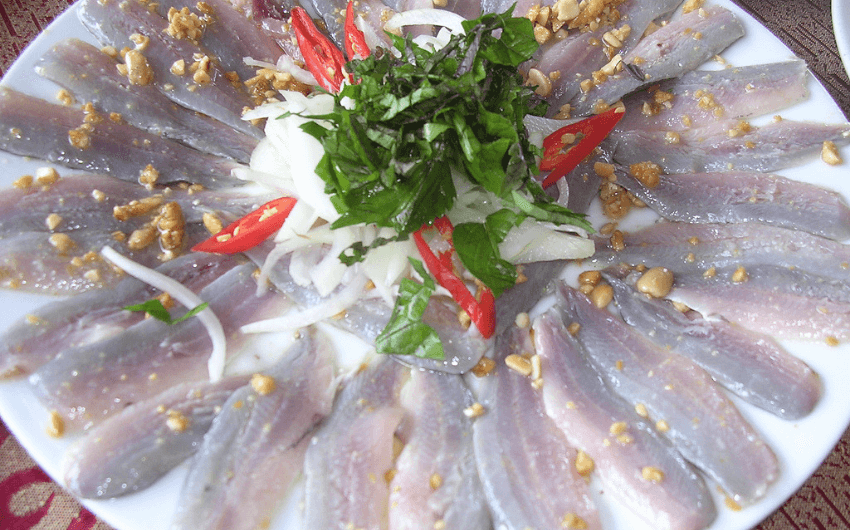
The Bong fish from the Lo river is lean, robust, and savory, and they don’t have the usual unpleasant smell. The fish are carefully selected to ensure only ones of 1.5 to 2 years old come to the kitchen. There they are cleaned and prepared for salad. Diners dip fish fillets in the fish’s processed bone powder and roll them with fragrance herbs and a dash of specially mixed sauce for a beautiful, unique taste.
Grilled fish on Ba Be lake
Enjoying grilled fish is a key activity for visitors who come to Ba Be lake, and it’s not just because these fish are good. Amidst the vastness of water and skies, angling the lake for a few fish, slide them between bamboo sticks to grill over a fire beside the waterline. A sip of wine brings all the experiences together harmoniously. The fish in Ba Be lake live freely in their natural habitat of cool waters all year round, which is why they are unusually nice and fresh and make the most excellent grill material.
Simple yet savoury seafood of the Northeast cuisine
Hand pounded squid paste – a distinct taste from Quang Ninh
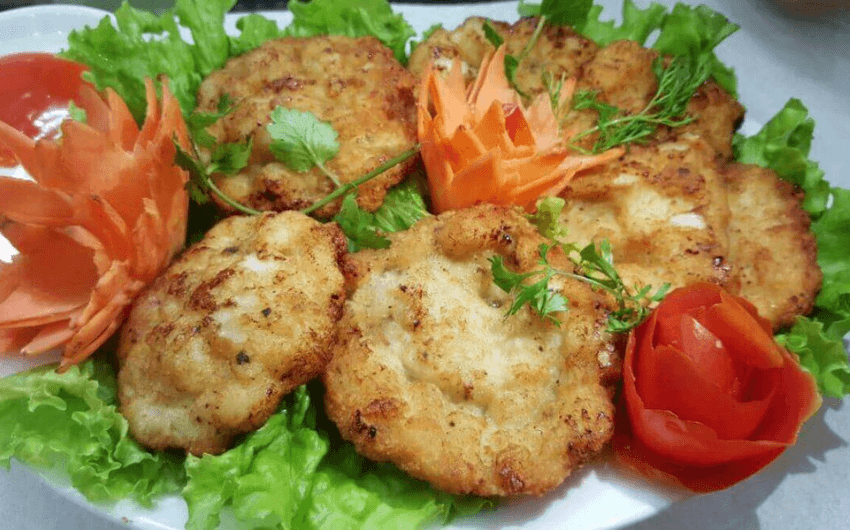
Hand-made squid paste is a delicate specialty of Quang Ninh province. Premium fresh squids were fished from the Tonkin Gulf. They then got pounded along with lean pork, some herbs, and young green rice (cốm) and shaped into palm-sized globs. As the paste is beaten by hand, it is firmer and retains more sweetness than one made with a blender. Squid paste performs excellently in sour rice noodle soup and tastes the best with white rice fried or simmered in tomato sauce.
Clam worm paste – a strange yet popular food of Quang Ninh
Clam worms are easy to be seen in Quang Ninh’s estuaries. Each year at “clam worm season”, they redden waterways, which urges locals to come to harvest. They have a rather flattened, elongated body. After cleaning, clam worm is mixed with a blend of minced pork, eggs, tangerine peel, herbs, and wood ear, then fried until it gets a delicious golden color. As an exquisite blend of premium ingredients, clam worm paste features a rich flavor and a killer scent.
Ngan clam of Quang Ninh
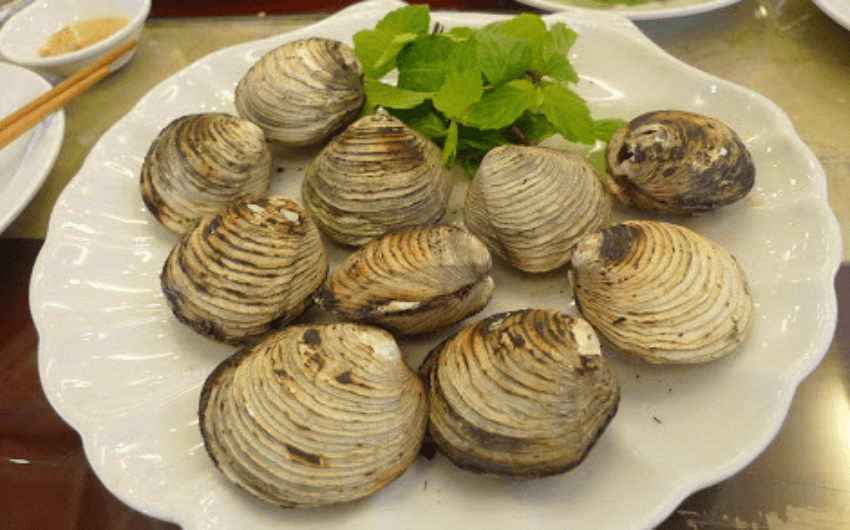
Ngan (Austriella corrugata) is a clam not unlike scallop and cockle, albeit larger. Its meat is savory sweet, thick but not chewy, and nourishing. Ngan can be roasted, steamed, or stirred and is always in high demand from visitors. It is one of the famous seafood exclusively available in Quang Ninh.
Peanut worm of Quang Ninh
The appearance of the peanut worm (Sa sung) can be alarming at first sight. Who would eat these? They look like pink, wobbling earthworms. But Sa sung is high-class seafood, an expensive one (priced at some $170 per kilogram). Sa sung is usually steamed or stir-fried with green onion and some dried peanuts to intensify the scent of the sea. It is surprisingly crunchy, very savory, and said to be good for men’s health.
Sticky rice dishes, a staple of Northeastern Vietnam cuisines
Steamed sweet rice with ant egg
Ant egg is a rare, very notable specialty of Vietnam’s northeast mountainous region. After carefully cleaning, the ant egg is lightly stirred with oil and green onion. It is then quickly mixed into the still steamy sweet rice, so the dish can be served hot. The lush, sweet, buttery mix of sweet rice and ant egg makes for an inviting, tasty dish.
Steamed canarium sweet rice – a specialty of the Northeast
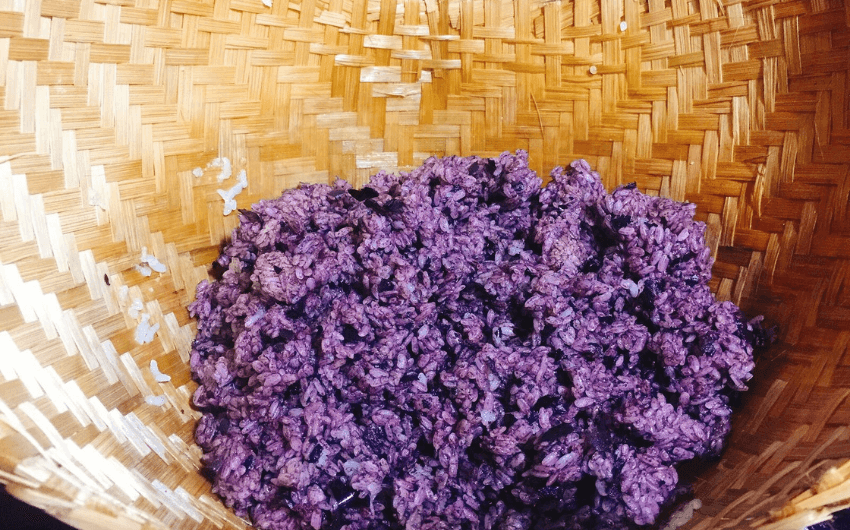
Canarium tree is widely grown for nuts around the low mountains of the Northeast. But only the black canarium was picked to cook with sweet rice. First, the fruits are steamed to be soft; then, the flesh is extracted and mashed. The pulp is then mixed into cleaned sweet rice and steaming pot. When the steamed rice has become nice and soft, it is added with some hot chicken fat. The rice gets a lush purple from canarium flesh. You will feel elastic and aromatic when putting it into your mouth. Now it would be excellent to have ready some roasted pork to make a pair of finger food suits.
Prismatic sweet rice
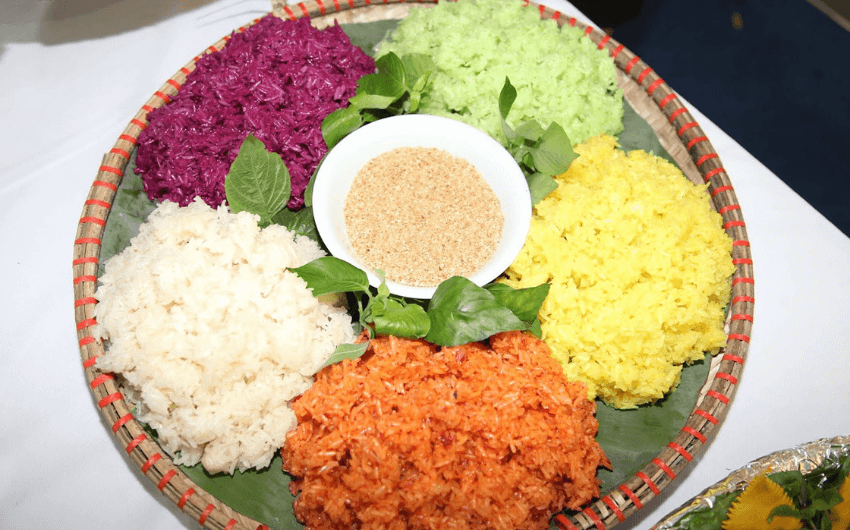
The folks in the north have a special style of making steamed sweet rice in their cuisine. The rice was displayed in five different colored sections: Yellow, white, purple, red, and orange. The colorful rice is used in ceremonial events like Tet, weddings, or funeral receptions. The eye-pleasing, natural hues come from vegetable and fruit extracts that only accrete the distinctive scent of the firm, elastic sweet rice. The dish is then served with meat, minced peanuts, or sesame with salt, which further enriches its taste and flavors.
Distinctive cakes and dumplings of Northeast Vietnam
Ant egg bun
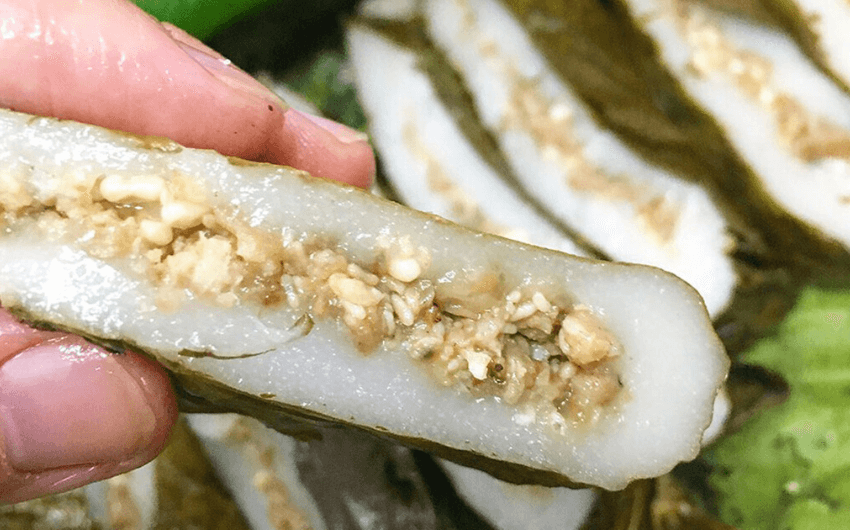
Each year, in April and May, the locals in Cao Bang again stream to the jungle in search of black ant nests for their traditional ant egg buns. Grand sticky rice flour, ant egg, and minced pork are the main ingredients. The egg is fried with pork, green onion, and chive to make the filling. The well-kneaded dough is flattened into 1 cm thick slabs on fig leaves. The filling is then spread on the slab and covered by another layer of dough. The buns are placed in a steaming pot to cook. When served, ant egg buns have a stretchy texture, a beautiful scent and starchy taste of sweet rice, and a savory, rich sensation from the ant egg. This is a special treat that should not be overlooked when you are traveling to the Northeast of Vietnam.
Cooc Mo rice dumpling
This is a well-known dish of the Tay people. Its name means Bull Horn. It is also shaped in a long cone, like a real horn. The dumplings are made from sweet rice with red peanuts for filler. They are then wrapped in patches of banana leaf or dong leaf and steamed well. Some might find these dumplings rather bland, so a little honey or purified sugar often appears on the tray to remedy that.
Lao Khoai bread
This food cannot be missing on the Tet holiday of the H’mong people of Northeast highlands. The main ingredient is well-steamed corn flour, shaped into oval slabs 15 to 20 cm long. The slabs were then baked on glowing charcoal. In the process, honey and fat are applied to the exterior, giving the bread an appealing sweetness, richness, and mouth-wetting aroma.
Banh gio dumpling
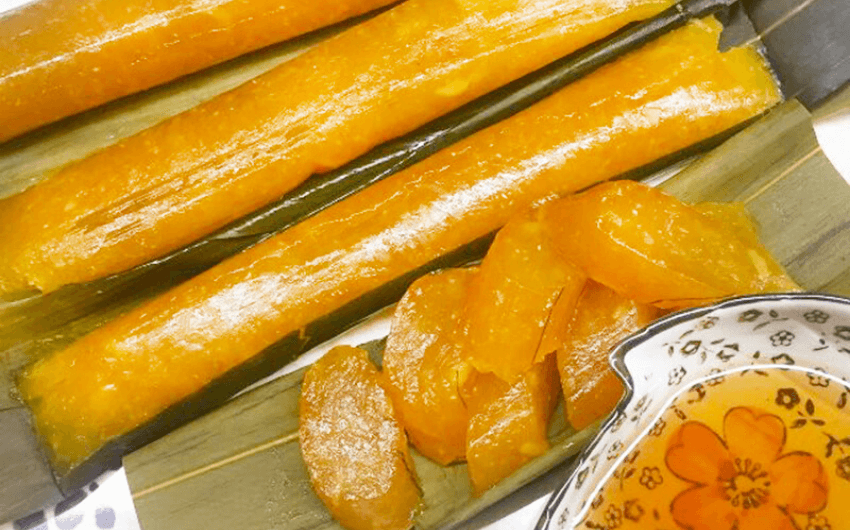
Banh gio (literally ash dumpling) is characteristic of the northeast Tay people. The rice is wrapped in broom grass leaves to a triangular or bar shape. The dumping is then boiled and eaten when cooled. It has an amber-like yellow, is a bit transparent, and would require some nectar or sugar to match your appetite.
Dong Van egg rice roll
Steamed rice roll is the ubiquitous dish everywhere in Vietnam and not just for Dong Van. But the rolls here are uncommonly attractive. They are very soft and smooth. Instead of minced pork and wood ear for filling, they have eggs.
And elsewhere, it is served with light fish sauce; here in Dong Van, the dipping sauce is much more delicate. It is clear bone stock with savory additions, crispy fried shallots, and green onion. The role might be cooled, but the dipping sauce is always kept scalding hot.
Gac pyramidal rice dumpling
The Gac pyramidal rice dumpling is a specialty of Tay and Dao people in the mountainous northeast region. The rice flour is wetted with water pressed from the gac fruit, so the dough has a vivid bright red or orange color. The dumpling has a slightly sweet and creamy flavor of gac and a soft, smooth texture. The filling is rich and savory. Some hot sauce is a perfect complement.
Popular fermented dishes of Northeast cuisine
Huu Lung roasted nem
The nem of Huu Lung is as big as a man’s wrist and is three-span in length. The cook encases sliced pork and other fillers in three layers of banana leaf, which facilitates nem’s fermentation. After carefully fastened, the nem is left to age naturally for three to five days. The whole log is placed on burning charcoal to be roasted on serving. The nem inside exudes a unique, charming fragrance when the hot leaves are unwrapped. This dish is best served with homemade chili sauce.
Thanh Son fermented pork – a fine dish of Muong people in Northeast Vietnam
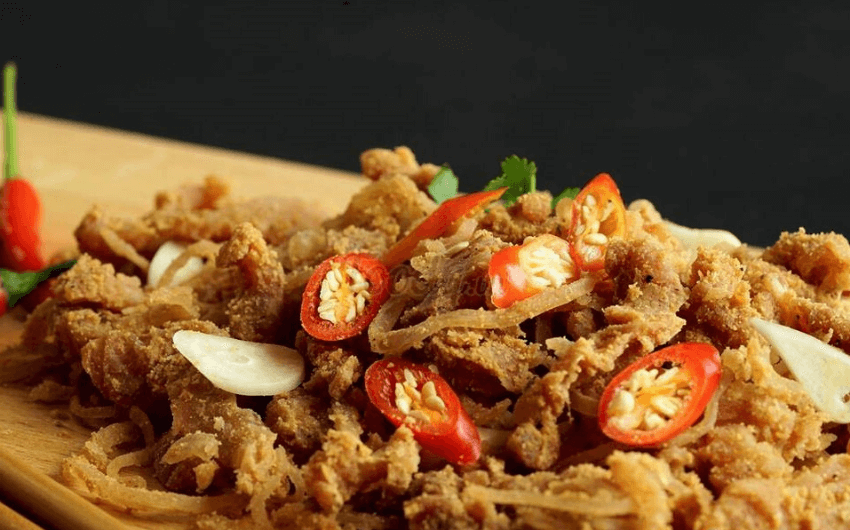
Thanh Son fermented pork is a proud dish of the Muong ethnic people. Traditionally, the pork is stuffed in bamboo tubes. But to accommodate the great demand today, it is contained in plastic jars. It is made from Man Pig pork and thinh, a special dried corn powder. The lean part is tough, the skin is crunchy, and all are covered in the delicious tang of thinh. Diners can roll a cluster of fig leaves around a piece of pork, dip it in hot sauce, and taste it. Thanh Son fermented pork has become a popular specialty of Phu Tho and attracts orders from many other provinces.
Cassava leaves broth
It is a remarkable broth of Phu Tho province. Cassava immature leaves are harvested, squeezed, immersed in a salt solution with bamboo shoots, and left for fermentation. These sour cassava leaves are best cooked with small fish or pork bones if the fishy smell is undesirable. The broth should be well cooked for over one hour. After that, the leaves would be adequately soft with a pleasant tart flavor, the water is savory, and the whole bowl releases a unique scent. The fermented cassava leaves can be stirred with fat crackling and produce a solid vegetable dish.
Best places to eat in Northeast Vietnam
Phuong Nam Ha Long Restaurant
Phuong Nam Ha Long has a large serviceable space designed to be in harmony with nature outside, on the shore of the beautiful Halong Bay. The space inside the restaurant is cool and airy with a remarkable large floor and features a full system of light, sound, and visuals. The restaurant is suitable for tourist groups and has long been a familiar site for events and congregations of Quang Ninh people. The price is always reasonable and depends on customers’ requirements.
Phuong Nam Ha Long Restaurant is known for its authentic East Asian cuisine. The excellent seafood in Ha Long is all available on the restaurant’s diverse menu. The best dishes from all three regions of Vietnam can be served here by its seasoned chef.
Bac Kan Cay Me Restaurant
The vendor serves meals and hotpots at low prices and unquestionable quality. The owner is friendly and can keep conversations flowing with valuable advice. A typical serving for a meal has fried rolls, meat-filled bamboo shoot, beef stirred with pickled veggie, and a woodland vegetable.
Song Lo Fish Restaurant in Ha Giang
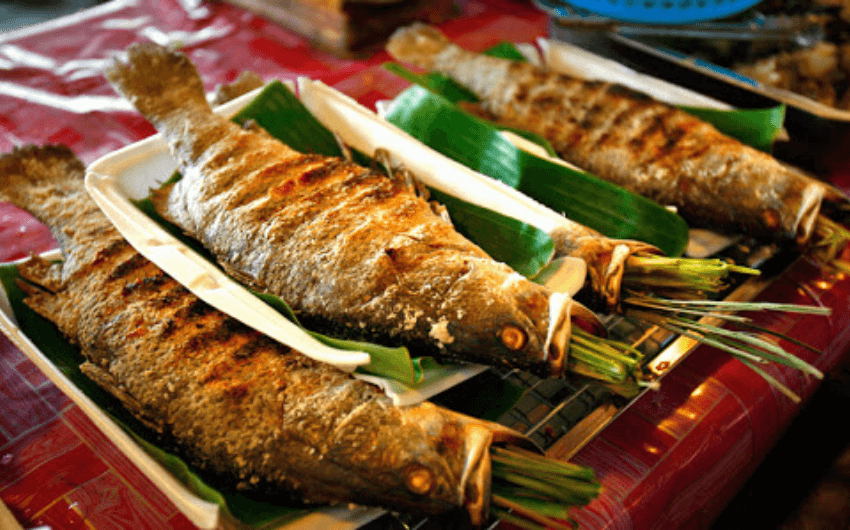
It is a remarkable model of a restaurant, built in imitation of a floating ship on the poetic Lo river. From this fair location, visitors can rest their eyes on the tender Lo river and far away on the Yen Bien bridge, where many couples chose as their romantic meeting place and from where stemmed many young families.
The restaurant features 27 tables, and five single, double, and community dining rooms with air coolers. It is an excellent choice for visitors to the province of Ha Giang. Come to the restaurant; guests can enjoy many delicious dishes from fish of the Lo river, prepared in local special methods, such as Hotpot, salad, roasted hemibagrus, sheatfish, sturgeon, sweet water turtle, etc.
Green Palm Frond Restaurant in Cao Bang
When listing great restaurants in northeast Vietnam, one cannot overlook the Green Palm Frond. It is the ideal place for you to get to know and enjoy the best and most special local dishes. The restaurant excels in serving Cao Bang dishes in their most good taste and presentation.
I must say that for sheer enjoyment in the North Vietnam food culture
Contact us for more interesting information
- Address: 3/7/36 Duy Tan Street, Cau Giay District, Ha Noi City
- Mobile: +84 976 024 986
- Email: [email protected]
- Website: https://vietnammotorbiketoursclub.com/
RELATED POSTS

Visiting Vietnam In March 2025? Top 10 Hottest Destinations
March is an ideal time to travel, with pleasant weather and fresh air, leaving many wondering which destination to choose. If you are also looking...
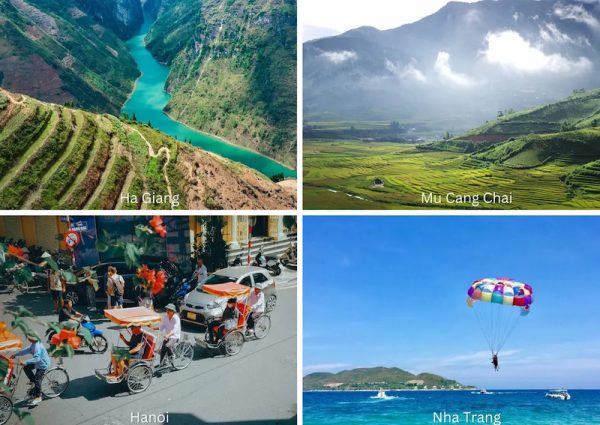
The Ultimate Guide to Visiting Vietnam In April 2025
April is a unique transitional period in Vietnam, bringing a pleasant atmosphere that is perfect for travel. It’s when the country blends the lingering coolness...

Ghenh Da Dia Phu Yen – A beautiful check-in location for tourists
Ghenh Da Dia Phu Yen – a unique natural wonder of Vietnam, where basalt rocks are stacked like giant honeycombs creating a magnificent picture in...




